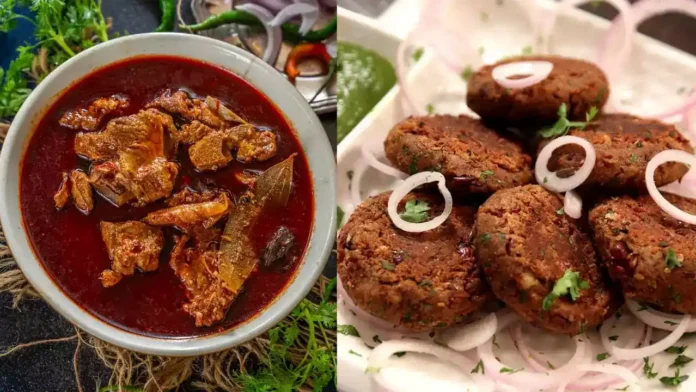India is renowned for its rich vegetarian cuisine, yet amidst the myriad vegetable-based delicacies, there exists a treasure trove of distinctive non-vegetarian dishes steeped in history, often overlooked. In a recent survey conducted by Taste Atlas, a digital platform ranking culinary delights, India’s Rogan Josh and Galouti Kebab claimed the 26th and 27th spots respectively among the top 100 lamb dishes worldwide.
The top five positions were dominated by Greece’s Paidakia, a dish of marinated lamb chops, followed by Turkey’s Cag kebab, Doner Kebab, and Adana Kebab. Spain’s Lecahzo rounded out the list in fifth place.
Let’s delve deeper into these two iconic dishes from Northern India.
Rogan Josh:
Rogan Josh, which comes from Kashmir, is well-known for its intense flavours and vivid red hue. The Persian origin of the name “Rogan” means “clarified butter or oil,” while the Hindi translation is “red.” “Josh” denotes ardour, frequently smouldering or heated. Thus, cooking in a hot, oil-based sauce is what makes rogan josh. The Mughals brought this dish to Kashmir as a result of their influence on Persian food.
Adapted to suit the distinct palate and cooking techniques of Kashmir, the dish underwent modifications from its original form. Despite the predominantly vegetarian menu of Kashmiri Brahmins, Rogan Josh became a staple in their regular diet. Their rendition omits onions and garlic, opting instead for fennel seeds and hing to enhance flavor, resulting in a delightful fusion with the lamb. In contrast, the Mughal version features abundant amounts of ginger and garlic.
Continue Exploring: Indian cuisine ranked 11th best in the world by TasteAtlas
Typically, rogan josh is prepared with slow-cooked lamb or goat, oil, yoghurt, and a variety of spices. Despite its bright red colour, it is usually not overly spicy. Rogan josh remains a popular dish in Northern India, and it is frequently found on the restaurant menus in the United States and Europe.
Galouti Kebab:
A classic dish in Lucknowi cuisine, this kebab from Uttar Pradesh traces its origins back to the era of the Nawabs of Awadh. Emerging from the royal kitchens in the late 17th century, the galouti or Tunday kebab was initially created for Nawab Mirza Asad-ud-Daula, known for his extravagant hospitality and culinary enthusiasm. With a penchant for meat dishes, particularly kebabs, the Nawab maintained a specialized team of chefs who continuously experimented to offer him an assortment of kebabs.
The term “galouti” translates to something that melts in the mouth, and indeed, this kebab lives up to its name, effortlessly dissolving upon tasting. Despite aging and encountering dental issues, the Nawab’s fondness for kebabs persisted. To accommodate his palate and ease of consumption, the royal chefs ingeniously devised the galouti kebab. Incorporating raw papaya paste into minced mutton, they achieved a soft, melt-in-the-mouth texture, ensuring the Nawab could enjoy his favorite dish with ease.
Traditionally, galouti kebabs feature tenderized minced meat, often sourced from goat or lamb, though variations with beef and chicken are also popular. The meat undergoes a meticulous hand-mincing process before being marinated with a blend of aromatic spices like cloves, cinnamon, cardamom, nutmeg, and mace.
Skillfully shaped into small, flat patties, the marinated meat mixture is cooked on a griddle over low heat, generously brushed with clarified butter. Galouti kebabs are traditionally served with parathas or rumali roti.
These two Indian dishes have become staples across the country and indeed around the world. However, they represent just a small portion of the numerous delectable non-vegetarian recipes that contribute to the rich culinary tapestry of the country.
Continue Exploring: Indian classic ‘Rajma Chawal’ earns global acclaim, ranks high on Taste Atlas’ Finest Bean Dishes List





